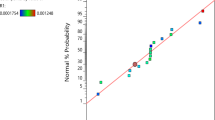Abstract
The mechanism of the formation of a protective anticorrosion coating on the surface of unalloyed steel treated with solutions of benzotriazole (BTA) and mercaprobenzothiazole (MBTA) in oil is studied by X-ray photoelectron spectroscopy (XPS). The anticorrosion effect of the mineral-oil compositions is demonstrated to be mediated by the formation of adsorption layers on the surface of steel which prevent its contact with moisture and aggressive chemical species. Using a Monicor corrosion monitoring meter, the protective effect of such composites is studied in a model corrosion medium which imitates the humidity condensate typical of industrial cities. The protective effect of our mineral-oil compositions containing the corrosion-inhibiting additives BTA and MBTA at concentrations of 1–5 wt % fully emerges only after the protective layer is heated to 50–150°C. The results of XPS analysis suggest the formation of chemisorption bonds between surface iron atoms and nitrogen atoms of the BTA molecule and nitrogen and sulfur atoms of the MBTA molecule at the indicated temperatures. This interaction between the atoms of inhibitor molecules and the iron atoms leads to the formation of a compact protective layer of mineral oil on the steel surface.




Similar content being viewed by others
REFERENCES
Yu. N. Mikhailovskii, Atmospheric Corrosion of Metals and Methods of Their Protection (Metallurgiya, Moscow, 1989) [in Russian].
E. R. Khairullina, Neftegazov. Delo. http://www.ogbus.ru.
I. L. Rozenfel’d, F. I. Rubinshtein, and K. A. Zhigalova, Protection of Metals from Corrosion by Paint and Varnish Coatings (Khimiya, Moscow, 1987) [in Russian].
V. I. Vigdorovich, L. E. Tsyganova, A. P. Pozdnyakov, and N. V. Shel’, Scientific Foundations, Practice of Creation, and Nomenclature of Anticorrosive Conservation Materials: Textbook (Tambov. Gos. Univ., Tambov, 2001) [in Russian].
A. D. Yakovlev, Chemistry and Technology of Paint Coatings: Textbook (Khimiya, Leningrad, 1981) [in Russian].
S. E. Krein and Yu. N. Shekhter, Nitrated Oils (Khimiya, Moscow, 1967) [in Russian].
Yu. I. Kuznetsov, Int. J. Corros. Scale Inhib. 9, 1142 (2020). https://doi.org/10.17675/2305-6894-2020-9-4-1
Ya. G. Avdeev and Yu. I. Kuznetsov, Int. J. Corros. Scale Inhib. 9, 1194 (2020). https://doi.org/10.17675/2305-6894-2020-9-4-3
Ya. G. Avdeev and Yu. I. Kuznetsov, Int. J. Corros. Scale Inhib. 9, 867 (2020). https://doi.org/10.17675/2305-6894-2020-9-3-5
N. A. Gladkikh, Candidate’s Dissertation in Chemistry (Inst. Phys. Chem. Electrochem. Russ. Acad. Sci., Moscow, 2020).
M. V. Kuznetsov, A. Ya. Zapevalov, L. V. Zolotukhina, I. G. Aref’ev, and B. R. Gel’chinskii, J. Surf. Invest.: X‑ray, Synchrotron Neutron Tech. 5, 447 (2011).
A. T. Kozakov, A. V. Nikol’skii, K. A. Guglev, V. G. Smotrakov, V. V. Eremkin, and E. M. Panchenko, J. Surf. Invest.: X-ray, Synchrotron Neutron Tech. 6, 238 (2012).
V. A. Trapeznikov, I. N. Shabanova, A. V. Kholzakov, and A. G. Ponomaryov, J. Electron Spectrosc. Relat. Phenom. 137–140, 383 (2004). https://doi.org/10.1016/j.elspec.2004.02.115
V. I. Nefedov, X-Ray Electron Spectroscopy of Chemical Compounds (Khimiya, Moscow, 1984) [in Russian].
NIST XPS Database Scientific Citation Search Result. srdata.nist.gov.
G. Beamson and D. Briggs, High Resolution XPS of Organic Polymers: The Scienta ESCA, 300 Database (Chichester, Wiley, 1992).
Practical Surface Analysis by Auger and X-ray Photoelectron Spectroscopy, Ed. by D. Briggs and M. Seah (Wiley, New York, 1983; Mir, Moscow, 1987).
T. Chasse, H. Peisert, P. Streubel, R. Szargan, A. Meisel, Acta Phys. Pol., A 83, 793 (1993).
Funding
The work was supported within a state assignment (state registration number AAAA-A17-117022250040-0) and performed using facilities of the center of collective use “Center of Physical and Physical-Chemical Analytical Methods and the Characterization of Surfaces, Nanostructures, Materials, and Products”, Udmurt Federal Research Center, Ural Branch, Russian Academy of Sciences. It was also supported by the Ministry of Education and Science of the Russian Federation within the federal target program “Research and Development in Priority Areas of Russia’s Scientific and Technological Potential for 2014–2020” (project ID RFMEFI62119X0035).
Author information
Authors and Affiliations
Corresponding authors
Ethics declarations
We declare that we have no conflicts of interest.
Rights and permissions
About this article
Cite this article
Shabanova, I.N., Reshetnikov, S.M., Naimushina, E.A. et al. X-Ray Photoelectron Study of the Mechanism of the Anticorrosion Effect of Benzotriazole and Mercaptobenzothiazole Additives to Mineral Oil. J. Surf. Investig. 15 (Suppl 1), S186–S192 (2021). https://doi.org/10.1134/S1027451022020367
Received:
Revised:
Accepted:
Published:
Issue Date:
DOI: https://doi.org/10.1134/S1027451022020367




